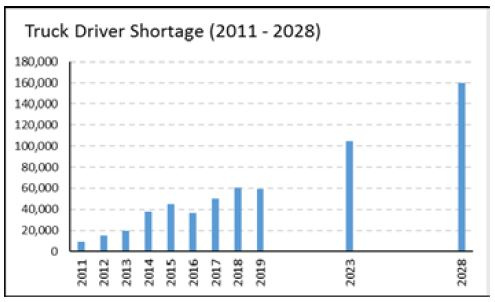Stop Hiring New Truck Drivers
Stop Hiring New Truck Drivers
BCMC Session: Effectively Managing Your Fleet to Stay Off the DOT Radar
Thomas Balzer, Ohio Trucking Association
Scott Wagner, Cascade Mfg Co
“We have only had to hire six drivers in the last 14 years, one of which was earlier this year to haul out of our newest facility in east Texas,” says Scott Wagner, director of manufacturing and safety for Cascade Mfg Co in Cascade, Iowa.
Likely most component manufacturers (CMs) would love to be able to say that, especially when you consider Cascade employs thirteen drivers spread between three production locations. Employee recruitment and retention is difficult for almost every aspect of the component manufacturing industry. Finding qualified and quality drivers can be especially challenging given the unique cargo our industry hauls and the acute driver shortage facing the trucking industry.
According to the American Trucking Associations, the trucking industry will need to hire roughly 1.1 million new drivers over the next decade, or an average of nearly 110,000 per year. Replacing retiring truck drivers will be the largest factor by far, accounting for over half of new driver hires (54 percent). The second largest factor will be industry growth, accounting for 25 percent of new driver hires.

That means the competition for quality drivers will only become more acute over the next decade. One way to avoid that fierce competition is to follow Cascade’s model of retention and not have to hire many drivers in the first place.
“Drivers are one of our most important assets as a company, and we treat them that way,” says Scott. “It starts by hiring high quality drivers, continually reinforcing a professional mentality, and compensating them accordingly so they are strongly motivated to stay part of our team.”
In practical terms, Scott says Cascade does background checks, motor vehicle record reviews, and drug and alcohol testing. When a driver first comes on board, they participate in two weeks of ride-alongs, receiving hands-on training from veteran drivers on everything from equipment and paperwork to load securement and jobsite delivery. “We spend a lot of time on the cargo we haul because it’s usually a lot different from what they’ve done in the past,” says Scott.
That training helps new drivers quickly feel part of the professional driver team at Cascade. To keep those drivers, Cascade does a lot to ensure the drivers’ needs are met. Cascade reimburses drivers for GPS equipment, ensuring they purchase reliable and accurate technology (as opposed to simply relying on their cell phones), as well as for steel toed boots and high visibility company t-shirts. Personal time off, flexible scheduling, and a host of other benefits also help ensure the drivers don’t get burned out.
They also bring in a mobile truck washing service every other week. “We find that a clean truck has a very positive impact on the drivers,” says Scott. “They treat the equipment better and they handle themselves more professionally.” Along with that, they have a “no exception” approach to equipment maintenance and load securement. This motivates every driver to pay close attention to their pre- and post-trip inspections and report any issues immediately.
Finally, Scott says they host an annual safety day for their drivers and pay close attention to the feedback they get from their drivers. “We make sure they know that they are heard and we try to address any concerns they have quickly and effectively,” says Scott. “The last thing we want as a company is for a driver to become disgruntled or for a maintenance issue to go unfixed.”
To help CMs, SBCA has developed an industry-specific driver training program for newly hired drivers, as well as a Safety Zone program to mitigate risks associated with jobsite deliveries.

